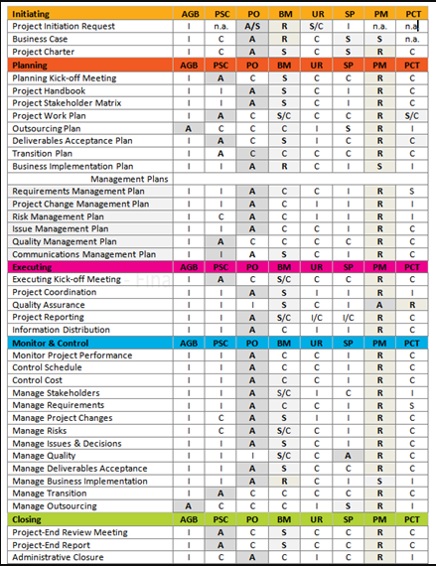Effective governance stands as a foundational element of sound management, serving as a Critical Success Factor (CSF) for all organizations, especially in the context of intricate programs and projects that engage multiple departments or organizations. These endeavors often operate with distinct procedures and cultures, each vying for its interests and perspectives.
Governance forms the structural backbone where management decisions find their place. Within this framework, it delineates roles along with their responsibilities and lays out the pathways for escalation and reporting.
In the context of a methodology, which emphasizes clear allocation of responsibilities and accountability, efficient decision-making processes, and avoidance of excessive committees, there are common antipatterns that can undermine effective governance. In this article, we’ll elaborate on these antipatterns and discuss how to help mitigate them.
 1. Not Promoting Decision Making at the Lowest Appropriate Level
1. Not Promoting Decision Making at the Lowest Appropriate Level
Effective governance promotes clear allocation of responsibility and accountability, allowing decisions to be made at the lowest appropriate level. The level of decision making authority should be well defined, and plenty of authority should be delegated to the lowest possible levels. In methodological approaches, the ARSCI model offers five degrees of responsibility, with “Accountable” and “Responsible” roles clearly defined. By adhering to these distinctions, teams can make decisions efficiently, without the need to escalate everything to the highest level. This prevents bottlenecks, ensures swift decision making and execution, and encourages ownership and responsibility at the appropriate levels.
2. Decision-Making via the Permanent Hierarchy
In highly hierarchical organisations, there is often a tendency for decisions to be made within functional structures, sidelining the dedicated temporary governance for project or programme. Methodologies advocate for the representation of the permenent hierarchy within the temporary governance structures. By ensuring this, the temporary governance structure becomes aligned with the organisation’s priorities and hierarchy, and decisions can be more easily accepted by the permanent governance framework, while allowing for the dedicated governance roles to make effective decisions.
2. Management by Committee
In organisations with a strong risk averse culture, there is often a tendency to manage everything by committee. This practice not only hampers decision-making but also reduces accountability and efficiency. Methodologies discourage management by Steering Committee as it leads to inefficiencies, and a lack of ownership. On the contrary, they encourage the use of the Steering Committees as a means to escalate issues or validate decisions from lower governance levels. This approach helps maintain a clear hierarchy of responsibility and accountability, ensuring that decision-making remains efficient and effective.
When everyone is responsible, no one is.
3. Whitewashing Responsibility via Overinvolvement
In some cases, organisations involve everyone in decision-making processes, often including entire functional departments in governance structures. This approach dilutes responsibility and hampers effective decision-making. This is a special case of “management by committee,” where senior managers from multiple departments or organisations discuss and decide on every management issue without the necessary project management knowledge or insights. Methodologies encourage clear role definitions and assignment of responsibilities to the most qualified individuals, those with the expertise and interest to participate, preventing the overinvolvement of unqualified parties.
 4. Allocation of Roles and Decision Making based on Politics
4. Allocation of Roles and Decision Making based on Politics
Another common antipattern in governance is the allocation of roles based on political or non-merit criteria. In this case, roles are distributed as honorary titles or tokens of appreciation, rather than based on qualifications and expertise. Methodology Mindsets emphasize the importance of assigning governance roles to the most appropriate people and making decisions for the benefit of the project or program, and not catering to organisational politics. By prioritizing competence over politics, governance structures can ensure that those in key positions have the necessary skills and knowledge to make informed decisions.
5. Decibel-Driven Decision Making
Another antipattern is decision-making driven by the loudest voices or functional authority, rather than being based on accurate information and established decision-making processes. This approach can lead to inconsistent and biased decision-making. Methodological approaches to governance provide formal management procedures that guide decision-making processes, reducing the influence of the loudest voice. By following these procedures, organisations promote rational and effective governance ensuring that decisions are made based on objective data and established processes.
6. Gaps and Overlaps in Responsibility
Effective governance models must ensure that there are no gaps or overlaps in responsibility. The ARSCI model for responsibilities allocation, provides a structured framework to assign and communicate responsibilities clearly. Know what your responsibilities are, and make sure others know what their are as well. This prevents confusion, promotes ownership, and helps teams work cohesively. By aligning roles with their corresponding responsibilities, governance can function more smoothly, reducing the likelihood of antipatterns.
 7. Management Entropy
7. Management Entropy
Management entropy describes the antipattern where governance processes deteriorate, and decisions are increasingly made on an ad-hoc basis, rendering established governance irrelevant. When this happens, governance can become chaotic, with governance structures falling apart. Methodological approaches emphasize the importance of maintaining and reinforcing the use of structured and logical governance frameworks. By adhering to methodological principles and procedures, organisations can avoid management entropy and ensure that governance remains systematic and relevant.
8. Reactive Decision Making
Finally, a significant antipattern is decision making becoming predominantly reactive. Senior managers and committees have a tendency to want focus on only addressing “real and important issues” and major crises, relegating proactive project management to the background. A methodological approach to management stresses the importance of both proactive and reactive management. By maintaining a balance between anticipating risks and managing issues and reacting to crises, organisations can ensure that governance remains effective, regardless of the challenges that arise.
The ARSCI Model for Assigning Responsibilities
Responsibility is not an on/off concept. The ARSCI Model defines five different degrees of responsibility, with the highest degree of responsibility being that of Accountable, and the second-highest being that of Responsible. Lower degree responsibilities are those of Support, Consulted and Informed. Note that the ARSCI model is in essence the same as the RASCI model. The reordering of the R and A is done to correctly reflect the order of the levels or responsibility from A being the highest to I being the lowest.
Closing Summary
Effective governance is paramount to project and programme success, and methodologies offers a structured approach to governance. By recognizing and mitigating common antipatterns, such as political role allocation, decibel-driven decision making, whitewashing responsibility, management entropy, and reactive decision making, organisations can establish governance models that are efficient, accountable, and conducive to successful project management. Methodologies’ emphasis on structured processes and robust governance frameworks ensure that governance remains reliable and adaptable in the face of various challenges.
See also:






